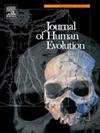The role of Denisovan paleohabitats in shaping modern human genetic resistance to viral, bacterial, and parasitic infections
IF 3.1
1区 地球科学
Q1 ANTHROPOLOGY
引用次数: 0
Abstract
Denisovans contributed notably to the genomes of present-day East and Southeast Asians. However, the relationship between the inhabited paleohabitats and the adaptive genetic traits related to infections in modern humans remains underexplored. This study uses geospatial techniques to analyze climatic factors associated with three Denisovan archaeological sites linked to nine specimens. Additionally, past and present climates and biomes, as well as the geographic distributions of eight infectious agents and disease vector groups, were modeled and compared with the modern genetic heritage of Denisovans. Findings reveal that the identified Denisovans inhabited subarctic and monsoon-influenced temperate climates, occupying boreal and seasonal forest biomes in the three studied archaeological sites. Sites such as Denisova Cave and Baishiya Karst Cave exhibited low climatic suitability for Ascaris lumbricoides, visceral leishmaniasis, and Nipah virus. Plasmodium vivax– and Aedes albopictus–like vectors plausibly were also not present. Conversely, Denisova Cave and Baishiya Karst Cave exhibit high climatic suitability for Ixodes persulcatus and Lyme borreliosis when Denisovans inhabited these sites. The paleoenvironment of the Laotian Cobra Cave site—with the exception of Nipah henipavirus—was suitable for all modeled pathogens and vectors. From the studied vectors and diseases, I. persulcatus and Lyme borreliosis are missing from Melanesia, where the region’s humans have the highest Denisovan legacy. This suggests that Denisovans from humid continental climates, such as those near Cobra Cave, may have contributed alleles providing adaptive advantages against ascariasis and mosquito-borne diseases in environments where modern human populations with high Denisovan genetic legacy reside.
丹尼索瓦人的古栖息地在塑造现代人类对病毒、细菌和寄生虫感染的遗传抵抗力中的作用
丹尼索瓦人对当今东亚和东南亚人的基因组做出了显著贡献。然而,人类居住的古栖息地与现代人感染相关的适应性遗传特征之间的关系仍未得到充分探讨。本研究使用地理空间技术分析了与三个丹尼索瓦考古遗址相关的气候因素,这些遗址与九个标本有关。此外,还模拟了过去和现在的气候和生物群落,以及八种传染因子和病媒群体的地理分布,并与丹尼索瓦人的现代遗传遗产进行了比较。研究结果显示,丹尼索瓦人居住在亚北极和受季风影响的温带气候中,占据了三个考古遗址的北方和季节性森林生物群落。丹尼索瓦洞和白石崖溶洞等地点对类蚓蛔虫、内脏利什曼病和尼帕病毒的气候适宜性较低。间日疟原虫和白纹伊蚊样媒介似乎也不存在。相反,丹尼索瓦洞穴和白石崖溶洞在丹尼索瓦人居住时表现出高度的气候适宜性。除尼帕-亨尼帕病毒外,老挝眼镜蛇洞遗址的古环境适合所有模型病原体和媒介。从所研究的病媒和疾病来看,美拉尼西亚缺少过硫螺旋体和莱姆氏疏螺旋体病,而该地区的人类拥有最高的丹尼索瓦人遗产。这表明,来自湿润大陆气候的丹尼索瓦人,例如眼镜蛇洞附近的丹尼索瓦人,可能在具有高丹尼索瓦遗传遗产的现代人居住的环境中,贡献了等位基因,提供了抵抗蛔虫病和蚊子传播疾病的适应性优势。
本文章由计算机程序翻译,如有差异,请以英文原文为准。
求助全文
约1分钟内获得全文
求助全文
来源期刊

Journal of Human Evolution
生物-进化生物学
CiteScore
6.30
自引率
15.60%
发文量
104
审稿时长
3 months
期刊介绍:
The Journal of Human Evolution concentrates on publishing the highest quality papers covering all aspects of human evolution. The central focus is aimed jointly at paleoanthropological work, covering human and primate fossils, and at comparative studies of living species, including both morphological and molecular evidence. These include descriptions of new discoveries, interpretative analyses of new and previously described material, and assessments of the phylogeny and paleobiology of primate species. Submissions should address issues and questions of broad interest in paleoanthropology.
 求助内容:
求助内容: 应助结果提醒方式:
应助结果提醒方式:


